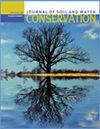Patterns and associations between dominant crop productions and water quality in an irrigated watershed
IF 2.6
4区 农林科学
Q2 ECOLOGY
引用次数: 0
Abstract
Irrigation consumes the largest share of freshwater resources, but is a necessary practice to boost agricultural output to meet increasing global demand for food and fiber. Irrigation not only impacts water quantity but can also degrade water quality. Research efforts have explored various aspects of irrigation efficiency and irrigated crop productivity, but few studies have examined how different crops collectively modulate water utilization and water quality at the watershed scale. The objective of this study was to determine how the fractions of evapotranspiration (fET) water ascribed to major crops impact water quantity and quality in irrigation return flow. In this study, long-term water quantity and quality monitoring data, collected as part of the Conservation Effects Assessment Project (CEAP), combined with crop and evapotranspiration (ET) modeling products, were used to build relationships between water quantity and quality metrics and fET associated with major crops during the first 15 years of the CEAP Twin Falls irrigation project. Results suggest that subwatershed size and subsurface flow contribution in regional drainage tunnels influenced the observed hydrologic patterns and led to two distinct groups. Subwatersheds in group 1 were large, typically included subsurface drain tunnels, and had high return flow volumes and low sediment concentration, while those in group 2 were smaller in size, had low return flow volumes, and high sediment concentration. Multiple linear regression analyses showed that spring and summer irrigation return flow volumes normalized by subwatershed area increased as a function of fET of potato (Solanum tuberosum) in group 1 (regression coefficients [coef.] = 4.42 in spring and 1.54 in summer) but were inversely associated with small grains in the fall (coef. = −1.67 and −0.60 in groups 1 and 2). Spring sediment concentration had negative regression coefficients with fET of sugar beet (Beta vulgaris) (coef. = −911.00) and alfalfa (Medicago sativa) + pasture crops (coef. = −424.85) in group 2. When statistically significant, a negative association was found between phosphorus (P) load per return flow volume and fET of alfalfa + pasture (coef. = −0.68 to −1.07), corn (Zea mays) (coef. = −0.64 to −0.89), dry beans (Phaseolus vulgaris) (coef. = −1.25 to −1.87), and sugar beet (coef. = −1.54 to −2.83) across aggregation periods and subwatershed groups. Nitrate (NO3-N) load per return flow volume was negatively associated with potato and corn fET in group 1 especially during the spring (coef. = −31.13 for potato and −9.60 for corn) and fall (coef. = −14.54 for potato and −4.43 for corn) months but positively associated with dry beans (coef. = 4.87) over the irrigation season. While direct cause and effect were not established with this analysis, results from this study provide valuable information about various crop production systems that may impact observed hydrologic responses.灌溉流域主要作物生产与水质之间的模式和联系
灌溉消耗淡水资源的最大份额,但却是提高农业产量以满足全球对粮食和纤维日益增长的需求的必要做法。灌溉不仅影响水量,而且会使水质恶化。研究工作已经探索了灌溉效率和灌溉作物生产力的各个方面,但很少有研究考察不同作物如何在流域尺度上共同调节水的利用和水质。本研究的目的是确定主要作物的蒸散发(fET)水组分如何影响灌溉回流中的水量和质量。在本研究中,利用作为保护效果评估项目(CEAP)的一部分收集的长期水量和质量监测数据,结合作物和蒸散(ET)模型产品,建立了CEAP双瀑布灌溉项目前15年期间与主要作物相关的水量和质量指标与蒸散效应(ET)之间的关系。结果表明,区域排水隧道的小流域大小和地下流量贡献影响了观测到的水文格局,并导致了两个不同的类群。第1组小流域面积大,一般包括地下排水隧道,回流体积大,含沙量低;第2组小流域面积小,回流体积小,含沙量高。多元线性回归分析表明,1组马铃薯(Solanum tuberosum)的效应效应系数(回归系数[coef;[春季= 4.42,夏季= 1.54],但与秋季小粒呈负相关(系数)。= - 1.67和- 0.60)。春季沉积物浓度与甜菜(Beta vulgaris)的fET呈负回归系数(coef)。=−911.00)和苜蓿(Medicago sativa) +牧草作物(coef。=−424.85)。在具有统计学显著性的情况下,苜蓿+牧草(coef)的单位回流流量磷(P)负荷与fET呈负相关。=−0.68 ~−1.07),玉米(Zea mays) (coef;=−0.64 ~−0.89),干豆(Phaseolus vulgaris) (coef;= - 1.25 ~ - 1.87),甜菜(coef。=−1.54 ~−2.83)。硝态氮(NO3-N)负荷量与马铃薯和玉米fET呈负相关,特别是在春季。= - 31.13马铃薯和- 9.60玉米)和秋天(coef。= - 14.54马铃薯和- 4.43玉米)月,但与干豆(咖啡)呈正相关。= 4.87)。虽然该分析没有确定直接的因果关系,但本研究的结果为可能影响观测到的水文响应的各种作物生产系统提供了有价值的信息。
本文章由计算机程序翻译,如有差异,请以英文原文为准。
求助全文
约1分钟内获得全文
求助全文
来源期刊
CiteScore
4.10
自引率
2.60%
发文量
0
审稿时长
3.3 months
期刊介绍:
The Journal of Soil and Water Conservation (JSWC) is a multidisciplinary journal of natural resource conservation research, practice, policy, and perspectives. The journal has two sections: the A Section containing various departments and features, and the Research Section containing peer-reviewed research papers.

 求助内容:
求助内容: 应助结果提醒方式:
应助结果提醒方式:


